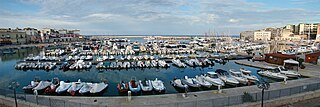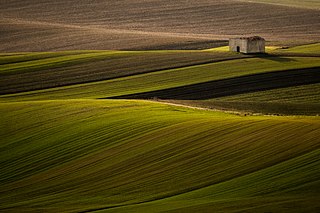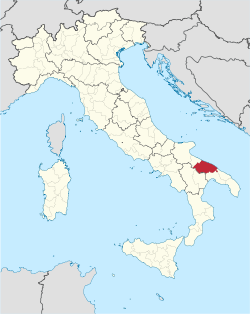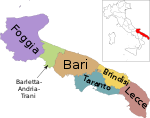
The province of Barletta-Andria-Trani is a province in the Apulia region of Italy. The establishment of the province took effect in June 2009, and Andria was appointed as its seat of government on 21 May 2010.

Bitonto is a comune in the Metropolitan City of Bari, in the Italian region of Apulia. It lies to the west of Bari. It is nicknamed the "City of Olives", due to the numerous olive groves surrounding the city.

Andria is a city and comune (municipality) in the Apulia region of Southern Italy. It is an agricultural and service center, producing wine, olives and almonds. It is the fourth-largest municipality in the Apulia region and the largest municipality of the province of Barletta-Andria-Trani. It is known for the 13th-century Castel del Monte.

Bisceglie is a city and municipality of 55,251 inhabitants in the province of Barletta-Andria-Trani, in the Apulia region, in southern Italy. The municipality has the fourth highest population in the province and fourteenth highest in the region.

Casamassima is a town and comune of 19,786 inhabitants in the Metropolitan City of Bari, in Apulia, southern Italy. Is also called "The Blue Town". The town is located inland from the Italian coastline, thrives and is built on agriculture, primarily that of wine, olives and almond production. Founded around the seventh and eighth centuries, the village started as a Roman encampment, according to legend.

Ruvo di Puglia is a city and comune (municipality) of 25,457 inhabitants in the Metropolitan City of Bari in Apulia.

The Parco Nazionale dell'Alta Murgia is a national park in Apulia, southern Italy, established in 2004. It lies in the Murgia geographical area, with its headquarters in the town of Gravina in Puglia, and has an area of 677.39 square kilometres. It is part of a larger Special Protection Area established to protect the grass steppe, lesser kestrel's habitat.

The Altopiano delle Murge is a karst topographic plateau of rectangular shape in southern Italy. Most of it lies within Puglia and corresponds with the sub-region known as Murgia or Le Murge. The plateau lies mainly in the Metropolitan City of Bari and the province of Barletta-Andria-Trani, but extends into the provinces of Brindisi and Taranto to the south, and into Matera in Basilicata to the west. The name is believed to originate from the Latin: murex, meaning 'sharp stone'.

The diocese of Ruvo was a Roman Catholic ecclesiastical territory in Apulia, southern Italy, which existed until 1986, when it was united into the diocese of Molfetta-Ruvo-Giovinazzo-Terlizzi. From 1818 to 1982, it was united with the diocese of Bitonto, as the diocese of Ruvo and Bitonto.

Eccellenza Apulia is the regional Eccellenza football division for clubs in the Southern Italian region of Apulia, Italy. It is competed among 18 teams, in one group. The winners of the Groups are promoted to Serie D. The club who finishes second also have the chance to gain promotion, they are entered into a national play-off which consists of two rounds.

La Gazzetta del Mezzogiorno is an Italian daily newspaper, founded in 1887 in Bari, Italy. It is one of the leading newspapers published in Southern Italy, with most of its readers living in Apulia and Basilicata.
Vito Di Bari is an Italian former footballer.
Ruvo is a railway station in the Italian town of Ruvo di Puglia, in the Province of Bari, Apulia. The station lies on the Bari–Barletta railway. The train services are operated by Ferrotramviaria.

Andria is a railway station in the Italian town of Andria, in the Province of Barletta-Andria-Trani, Apulia. The station lies on the Bari–Barletta railway. The train services are operated by Ferrotramviaria.

Bari Centrale is the main railway station of the Italian city of Bari, capital of Apulia. It is one of the most important railway stations in Italy, with an annual ridership of 14 million.

The Metropolitan City of Bari is a metropolitan city in the Apulia region of Italy. Its capital is the city of Bari. It replaced the province of Bari and includes the city of Bari and some forty other comuni. It was first created by the reform of local authorities and then established by the Law 56/2014. It has been operative since January 1, 2015.
The Andria–Corato train collision happened late in the morning of 12 July 2016 when two regional passenger trains on a single-track section of the Bari–Barletta railway collided head-on between the towns of Andria and Corato in the Apulia region of southern Italy. Twenty-three people were killed and 54 injured. The stretch of track is operated by regional rail company Ferrotramviaria.
Strada provinciale 3 Minervino-Spinazzola , previously known as Strada regionale 6 della Murgia Centrale , is a provincial road in Apulia, the route of which takes place entirely in the province of Barletta-Andria-Trani. It has two lanes in each direction, an emergency lane and a central reservation, is free of level intersections and has a total length of about 35 km (22 mi).

The culture of Apulia, the region that constitutes the extreme southeast of the Italian peninsula, has had, since ancient times, mixed influences from the West and the East, due to its strategic position near the transition zone between these two cultural regions. Its location, on the west coast of the Adriatic and Ionian seas, the natural southern border between Western Europe and the Balkans and Greece, made it a bridge to the East since antiquity, and in the Middle Ages, it was a cultural frontier between the Roman-Germanic West and the Greek-Byzantine East.



















